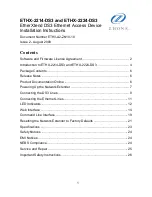
58
link, while hosts generate an "interface identifier" that uniquely identifies an interface on a subnet. An
address is formed by combining the two. When using stateless configuration, you needn’t configure
anything on the client.
Stateful configuration
, for example using DHCPv6 (which resembles its counterpart DHCP in IPv4.)
In the stateful auto configuration model, hosts obtain interface addresses and/or configuration
information and parameters from a DHCPv6 server. The Server maintains a database that keeps track
of which addresses have been assigned to which hosts.
DHCPv6 Server:
Check whether to enable DHCPv6 server.
DHCPv6 Server Type:
Select Stateless or Stateful. When DHCPv6 is enabled, this parameter is
available.
Stateless:
If selected, the PCs in LAN are configured through RA mode, thus, the PCs in LAN
are configured through RA mode, to obtain the prefix message and generate an address using
a combination of locally available information (MAC address) and information (prefix)
advertised by routers, but they can obtain such information like DNS from DHCPv6 Server.
Stateful:
If selected, the PCs in LAN will be configured like in IPv4 mode, thus obtain addresses
and DNS information from DHCPv6 server.
Start interface ID:
enter the start interface ID. The IPv6 address composed of two parts, thus, the
prefix and the interface ID. Interface is like the Host ID compared to IPv4.
End interface ID:
enter the end interface ID.
Leased Time (hour):
the leased time, similar to leased time in DHCPv4, is a time limit assigned to
clients, when expires, the assigned ID will be recycled and reassigned.
Router Advertisement:
Check to Enable or Disable the Issue Router Advertisement feature. This
feature is to send Router Advertisement messages periodically which would multicast the IPv6 Prefix
information (similar to v4 network number 192.168.1.0) to all LAN devices if the field is enabled. We
suggest enabling this field.
















































